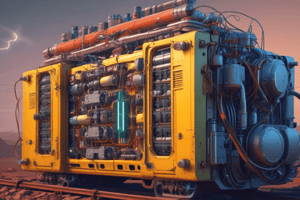Podcast
Questions and Answers
يعتبر البطاريات دوراً حيوياً في الدوائر الكهربائية حيث تضمن وجود تزويد مستمر بالطاقة الكهربائية اللازمة لتشغيل مختلف العناصر مثل الليدات، المحركات، والمتحسسات، والميكروكنترولرات. بالإضافة إلى ذلك، تعتمد اختيار نوع ال______ على عوامل مثل متطلبات الدائرة (الجهد، التيار)، المساحة المتاحة للتوضيع، واعتبارات التكلفة. ال______ تلعب دوراً حيوياً في الدوائر حيث تضمن وجود تزويد مستمر بالطاقة الكهربائية اللازمة لتشغيل المكونات المختلفة مثل الليدات، المحركات، المستشعرات، والميكروكنترولرات.
يعتبر البطاريات دوراً حيوياً في الدوائر الكهربائية حيث تضمن وجود تزويد مستمر بالطاقة الكهربائية اللازمة لتشغيل مختلف العناصر مثل الليدات، المحركات، والمتحسسات، والميكروكنترولرات. بالإضافة إلى ذلك، تعتمد اختيار نوع ال______ على عوامل مثل متطلبات الدائرة (الجهد، التيار)، المساحة المتاحة للتوضيع، واعتبارات التكلفة. ال______ تلعب دوراً حيوياً في الدوائر حيث تضمن وجود تزويد مستمر بالطاقة الكهربائية اللازمة لتشغيل المكونات المختلفة مثل الليدات، المحركات، المستشعرات، والميكروكنترولرات.
بطارية
تعد ال______ مكونات رئيسية في الدوائر الكهربائية، حيث تعمل كمسارات موصلة لتدفق الشحنة الكهربائية أو التيار الكهربائي بين الأجهزة. تتألف من مواد موصلة مثل النحاس والألومنيوم والفضة مغلفة بمواد عازلة لحمايتها من الاختراق وضمان السلامة أثناء التعامل.
تعد ال______ مكونات رئيسية في الدوائر الكهربائية، حيث تعمل كمسارات موصلة لتدفق الشحنة الكهربائية أو التيار الكهربائي بين الأجهزة. تتألف من مواد موصلة مثل النحاس والألومنيوم والفضة مغلفة بمواد عازلة لحمايتها من الاختراق وضمان السلامة أثناء التعامل.
أسلاك
يعتبر ال[بيان] جزءاً أساسياً في الدوائر الإلكترونية الذي يسمح بالتحكم في الأجهزة والدوائر الكهربائية. يمكن أن يكون ميكانيكيًا أو إلكترونيًا، ويعمل عن طريق قطع أو إكمال الاتصال الكهربائي بين طرفين.
يعتبر ال[بيان] جزءاً أساسياً في الدوائر الإلكترونية الذي يسمح بالتحكم في الأجهزة والدوائر الكهربائية. يمكن أن يكون ميكانيكيًا أو إلكترونيًا، ويعمل عن طريق قطع أو إكمال الاتصال الكهربائي بين طرفين.
مفتاح
يتألف المصباح الكهربائي من [بيان] يحول الطاقة الكهربائية إلى ضوء. يعتمد أداء المصباح على جودة هذا الجزء.
يتألف المصباح الكهربائي من [بيان] يحول الطاقة الكهربائية إلى ضوء. يعتمد أداء المصباح على جودة هذا الجزء.
الأسلاك تتألف من مواد موصلة مثل النحاس، الألومنيوم، أو الفضة، مغلفة بمادة عازلة لحمايتها ضد القصر الكهربائي وضمان السلامة أثناء ال[بيان].
الأسلاك تتألف من مواد موصلة مثل النحاس، الألومنيوم، أو الفضة، مغلفة بمادة عازلة لحمايتها ضد القصر الكهربائي وضمان السلامة أثناء ال[بيان].
Flashcards are hidden until you start studying
Study Notes
Simple Electrical Circuit Components: Understanding the Functions of Batteries, Wires, Switches, and Light Bulbs
In the field of electronics, several components play crucial roles in creating functional circuits. Among these essential components, batteries, wires, switches, and light bulbs are fundamental pieces that facilitate the controlled flow of electrical energy. Each component performs specific tasks within a circuit, contributing to the overall functionality of the device. This article aims to provide a detailed understanding of these four fundamental circuit components: batteries, wires, switches, and light bulbs.
Batteries
Batteries are essential power sources for electronic devices, providing the necessary electrical energy to drive various components within a circuit. They come in different sizes, shapes, and capacities, with the most common types being rechargeable lithium-ion batteries and non-rechargeable alkaline batteries. In simple circuits, a battery is connected between two terminals, one positive (+) and one negative (-), supplying current that flows through the rest of the circuit. The voltage provided by a battery is determined by the chemistry of the battery itself, with typical values ranging from 1.5 volts (for AA alkaline batteries) to 3.7 volts (for common lithium-ion cells).
Batteries play a critical role in circuits since they ensure there is a continuous supply of electrical energy needed to power various components such as LEDs, motors, sensors, and microcontrollers. Furthermore, the choice of battery type depends on factors like circuit requirements (voltage, current), available space for placement, and cost considerations.
Wires
Wires are key components in electrical circuits, serving as conductive pathways for the flow of electric charge or current between devices. They consist of conductive materials such as copper, aluminum, or silver, enclosed in insulating material to protect against short-circuiting and ensure safety during handling. There are different types of wires, including solid-core wires, stranded wires, and shielded wires, suitable for various applications based on their flexibility, stiffness, and ability to carry a specific amount of current.
The diameter of a wire affects the maximum amount of electric current it can safely carry without overheating. According to Ohm's Law, amperage (I) is directly proportional to resistance (V/I), meaning that thicker wires have lower resistance and can handle higher current flows. Proper selection of wire thickness is crucial to ensure optimal circuit performance, prevent overloading, and avoid electrical hazards due to excessive heat generation.
Switches
Switches are essential components in electronic circuits that allow for the control of electrical devices and circuits. They can be mechanical or electronic, and they operate by either interrupting or completing an electrical connection between two terminals. The function of a switch is to act as an on/off controller, enabling or disabling current flow within a circuit based on user input or external stimuli.
Switches come in various types and configurations, such as toggle switches, push-button switches, rotary switches, slider switches, and slide switches. These different switch types cater to specific use cases and design considerations, offering flexibility in terms of form factor, switching mechanism, and environmental requirements. By incorporating switches into a circuit, users gain the ability to turn devices on or off at will, adjust power levels, or even select multiple operating modes.
Light Bulbs
Light bulbs are common output components in electrical circuits that convert electrical energy into light energy. They typically contain a filament made of tungsten, which heats up due to resistive heating when electric current flows through it. As the filament temperature increases, it emits visible light as well as heat, illuminating the surrounding area.
There are different types of light bulbs available, including incandescent bulbs, LED bulbs, fluorescent bulbs, halogen bulbs, and HID bulbs. Each type employs unique technologies to generate light, resulting in variations in energy efficiency, lifespan, color temperature, and overall performance. By incorporating light bulbs into a circuit, users gain the ability to create visible light effects, such as signaling indicators or visual displays, or to generate adequate lighting for specific environments.
By understanding the role of these four components and how they interact within an electrical circuit, individuals can develop a deeper appreciation for the complex interplay of technology, design, and energy flow involved in modern electronic systems.
Studying That Suits You
Use AI to generate personalized quizzes and flashcards to suit your learning preferences.




